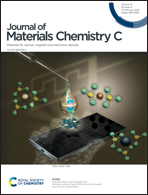Coordination units of Mn2+ modulation toward tunable emission in zero-dimensional bromides for white light-emitting diodes†
Abstract
Organic–inorganic metal halides have become a multifunctional platform for manipulating photoluminescence due to highly efficient and tunable emissions, especially for lead-free Mn2+-based halides. Herein, the zero-dimensional (0D) bromides of (C5H14N3)2MnBr4 and (CH6N3)2MnBr4 with different coordination environments were designed and synthesized by a solvent evaporation method. They exhibit green and red broadband emission peaks at 528 nm and 627 nm with high photoluminescence quantum yields of 86.83% and 61.91%, respectively, which are attributed to the d–d transition (4T1(G) → 6A1(S)) of [MnBr4]2− tetrahedral and [Mn3Br12]6− octahedral units. The cases emphasize the effect of organic ligands on the intrinsic emissions of Mn2+ ions, thereby revealing the luminescence mechanism of Mn2+ ions in 0D isolated structures through the Tanabe–Sugano (TS) energy diagram. Thanks to their bright and stable emissions, the fabricated white light-emitting diode (LED) based on (C5H14N3)2MnBr4 and (CH6N3)2MnBr4 provides an outstanding color rendering index (Ra) of 90.8 at a correlated color temperature (CCT) of 3709 K, along with the CIE chromaticity coordinates of (0.3985, 0.3979) and a luminous efficacy of 51.2 lm W−1. This work aims at clarifying the relationship between the coordination units of Mn2+ and tunable emissions, and in particular, proposes a new strategy to explore phosphors excited by blue light for white LEDs.

- This article is part of the themed collection: Editor’s choice collection: luminescent metal halides


 Please wait while we load your content...
Please wait while we load your content...